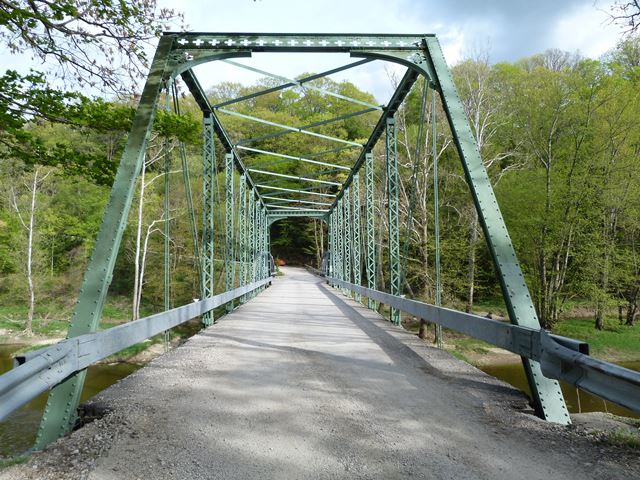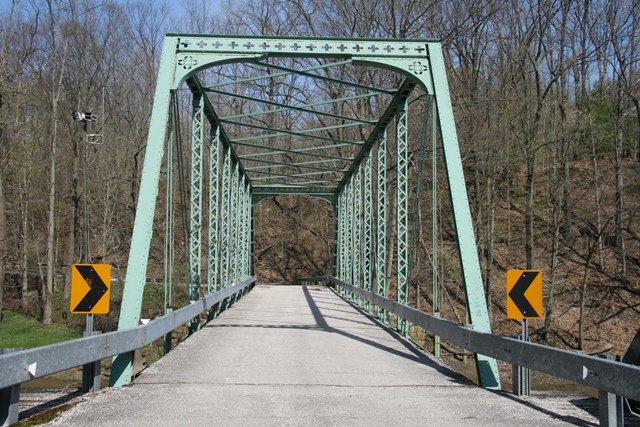We Recommend:
Bach Steel - Experts at historic truss bridge restoration.
BridgeHunter.com Phase 1 is released to the public! - Visit Now
Clyde Hill Road Bridge

Primary Photographer(s): Nathan Holth and Rick McOmber
Bridge Documented: April 30, 2011 and May 6, 2013
Rural: Ashtabula County, Ohio: United States
1889 By Builder/Contractor: Morse Bridge Company of Youngstown, Ohio
2003
130.0 Feet (39.6 Meters)
260.0 Feet (79.2 Meters)
16.7 Feet (5.09 Meters)
2 Main Span(s)
432474

View Information About HSR Ratings
Bridge Documentation
This was a two span bridge, but one through truss span was lost and replaced with a modern welded truss. Thus, only the northern, original span of this bridge is being evaluated and discussed here. This original span is in itself, a beautiful and significant example as a product of the Morse Bridge Company. The Morse Bridge Company is noted for its bridges with a variety of ornamental details that varies from bridge to bridge. It is also known for the extremely odd detail of through trusses without struts or sway bracing, instead using only heavy angles in the lateral bracing, which also provides the function that struts and sway bracing normally provide. The bridge has very thick cover plate. If a typical truss bridge has perhaps 1/4 inch thick cover plate, this bridge has perhaps half inch thick cover plate.
HistoricBridges.org strongly disagreed with the original Not Eligible finding of the Historic Bridge Inventory below, which also failed to identify the builder of the bridge. This is one of the last Morse Bridge Company bridges left in Ohio thanks to demolition, and this bridge is unaltered, and retains the distinct details of its builder including ornamental portal bracing and lack of struts and sway bracing. This bridge should be given a high preservation priority because it is one of the last of this Ohio bridge builder's work that is actually in Ohio. Fortunately, the bridge appears to be in good condition as of 2013. In 2014, the Ohio Department of Transportation concurred with a letter from HistoricBridges.org explaining the significance of this bridge and the bridge was reassessed and found formally eligible for listing in the National Register of Historic Places.
View Archived National Bridge Inventory Report - Has Additional Details and Evaluation
View 2014 Updated Historic Bridge Inventory Sheet For This Bridge
Information and Findings From Ohio's Historic Bridge InventorySetting/Context The bridge is closed to traffic. It is in a wooded rural setting. Physical Description The skewed, 2-span, 260'-long bridge has one pin-connected Pratt thru truss span with built-up compression members, eye bar or rod tension members, portal bracing with cruciform cutouts and brackets, and lattice railings. It was placed in 1889. A second similar span was lost in 2002 and replaced with a welded Warren pony truss. Integrity Span replaced in 2002. Summary of Significance The 1889 pin-connected truss bridge has lost one of its two original spans, which was replaced in 2002 with a Warren pony truss. The bridge has lost integrity of original design, and although the remaining span is a complete example, more complete examples exists in the state and county. The builder is not documented in available county records. The not eligible recommendation of the prior inventory remains appropriate. Pratt trusses were undoubtedly the most popular truss design of the last quarter of the 19th century and continued to be built into the 20th century, although eventually superseded in popularity by Warren trusses. The design, which initially was a combination of wood compression and iron tension members, was patented in 1844 by Thomas & Caleb Pratt. Ohio has three covered bridges that use this combination configuration, but they are all modern reconstructions based on the Pratt patent. The great advantage of the Pratt over other designs was the relative ease of calculating the distribution of stresses. More significantly, it translated well into an all-metal design in lengths of less than 200'. Significant surviving examples of all-metal Pratt trusses mostly date to the last quarter of the 19th century, and they are found with thru, pony, and the less common bedstead configuration. Prior to about 1890, a variety of panel point connections were in widespread use (including bolts, cast-iron pieces, and pins), but engineering opinion was coalescing around pins as the most efficient and constructible. Many of the connection details were proprietary and associated with individual builders or companies, and thus earlier examples are generally taken to be technologically significant in showing the evolution of the design. Later post-1890 Pratt trusses show a progression toward less variation in their details such that by 1900 the design was quite formulaic with few significant differences between the designs of various builders. This marked the end of the pin-connected Pratt's technological evolution and, in fact, it was soon waning and eclipsed in the highway bridge market by more rigid, rivet-connected truss designs, particularly the Warren but also riveted Pratts. The transition to riveted connections, which happened even earlier with railroads than highways, was in no small part due to concerns about stress reversals at the pins under heavier loads and improvements in pneumatic field riveting equipment in the early 1900s. In Ohio, Pratt truss highway bridges, whether pinned or riveted, were almost always built under the auspices of counties and local units of government; the Pratt was not a standard design of the state highway department. In Ohio, there are 185 Pratt trusses dating from ca. 1874 to 1945 with at least 60 dating prior to 1900 (Phase 1A, 2008). The technologically significant unaltered examples of pin-connected Pratt trusses for the most part date prior to 1900 and have documented or attributed builders and dates of construction and/or significant connection or member details. Later post-1900 examples are less technologically significant. Significant unaltered examples of riveted-connected Pratt trusses date from ca. 1900 to 1915. Bridge Considered Historic By Survey: Initially No, Found Eligible In 2014 |
This bridge is tagged with the following special condition(s): Unorganized Photos
![]()
Photo Galleries and Videos: Clyde Hill Road Bridge
Bridge Photo-Documentation
Original / Full Size PhotosA collection of overview and detail photos. This gallery offers photos in the highest available resolution and file size in a touch-friendly popup viewer.
Alternatively, Browse Without Using Viewer
![]()
Bridge Photo-Documentation
Mobile Optimized PhotosA collection of overview and detail photos. This gallery features data-friendly, fast-loading photos in a touch-friendly popup viewer.
Alternatively, Browse Without Using Viewer
![]()
CarCam: Northbound Crossing
Full Motion VideoNote: The downloadable high quality version of this video (available on the video page) is well worth the download since it offers excellent 1080 HD detail and is vastly more impressive than the compressed streaming video. Streaming video of the bridge. Also includes a higher quality downloadable video for greater clarity or offline viewing.
![]()
CarCam: Southbound Crossing
Full Motion VideoNote: The downloadable high quality version of this video (available on the video page) is well worth the download since it offers excellent 1080 HD detail and is vastly more impressive than the compressed streaming video. Streaming video of the bridge. Also includes a higher quality downloadable video for greater clarity or offline viewing.
![]()
Additional Unorganized Photos
Original / Full Size PhotosA supplemental collection of photos that are from additional visit(s) to the bridge and have not been organized or captioned. This gallery offers photos in the highest available resolution and file size in a touch-friendly popup viewer.
Alternatively, Browse Without Using Viewer
![]()
Additional Unorganized Photos
Mobile Optimized PhotosA supplemental collection of photos that are from additional visit(s) to the bridge and have not been organized or captioned. This gallery features data-friendly, fast-loading photos in a touch-friendly popup viewer.
Alternatively, Browse Without Using Viewer
![]()
Maps and Links: Clyde Hill Road Bridge
Coordinates (Latitude, Longitude):
Search For Additional Bridge Listings:
Bridgehunter.com: View listed bridges within 0.5 miles (0.8 kilometers) of this bridge.
Bridgehunter.com: View listed bridges within 10 miles (16 kilometers) of this bridge.
Additional Maps:
Google Streetview (If Available)
GeoHack (Additional Links and Coordinates)
Apple Maps (Via DuckDuckGo Search)
Apple Maps (Apple devices only)
Android: Open Location In Your Map or GPS App
Flickr Gallery (Find Nearby Photos)
Wikimedia Commons (Find Nearby Photos)
Directions Via Sygic For Android
Directions Via Sygic For iOS and Android Dolphin Browser
USGS National Map (United States Only)
Historical USGS Topo Maps (United States Only)
Historic Aerials (United States Only)
CalTopo Maps (United States Only)



